Sustainable Jewelry Companies: Find Eco-Friendly Jewelry Options

As consumers become more environmentally conscious, the demand for eco-friendly jewelry brands is on the rise. We are witnessing a significant shift in consumer behavior towards sustainability, and the jewelry industry is no exception.
At the forefront of this movement are sustainable jewelry companies that prioritize the environment and ethical sourcing. We recognize the importance of adopting eco-friendly practices and promoting these companies that lead the way in responsible jewelry manufacturing.
In this article, we will explore the world of sustainable jewelry, highlighting key factors to consider when choosing eco-friendly options and showcasing leading companies that make a difference.
Key Takeaways
- Eco-friendly jewelry brands are gaining popularity due to increasing environmental awareness.
- Sustainable jewelry companies prioritize ethical sourcing and environmentally responsible practices.
- Key factors to consider when choosing eco-friendly jewelry include material sourcing and production methods.
- Leading sustainable jewelry companies are setting new standards in the industry.
- Consumer demand is driving the shift towards sustainability in the jewelry industry.
Understanding Sustainable Jewelry
The concept of sustainable jewelry encompasses a broad range of practices aimed at reducing environmental footprint and promoting ethical sourcing. As we explore this topic, it’s crucial to understand the multifaceted nature of sustainability in the jewelry industry.
What Makes Jewelry Sustainable?
Sustainable jewelry is characterized by its minimal environmental impact and ethical production processes. This includes the use of recycled precious metals, conflict-free diamonds, and eco-friendly production methods. We look for jewelry that is designed and manufactured with the environment and society in mind.
- Use of recycled materials
- Conflict-free sourcing of diamonds and gemstones
- Eco-friendly production processes
- Fair labor practices throughout the supply chain
The Environmental Impact of Traditional Jewelry
Traditional jewelry production is often associated with significant environmental degradation, including deforestation, water pollution, and soil erosion due to mining activities. We must consider these impacts when evaluating the sustainability of jewelry.
The extraction of precious metals and gems can lead to habitat destruction and biodiversity loss. Furthermore, the use of toxic chemicals in the refining process poses serious health risks to both local communities and the environment.
Key Sustainability Certifications to Look For
To ensure that jewelry is sustainably sourced and produced, we look for various certifications. These include Fairmined and Fairtrade Gold, which guarantee that the jewelry is produced with fair labor practices and minimal environmental impact.
- Fairmined certification for responsible mining practices
- Fairtrade Gold certification for fair labor practices and environmental responsibility
- Other certifications like the Kimberley Process for conflict-free diamonds
By understanding these aspects, consumers can make informed decisions when purchasing jewelry, supporting companies that prioritize sustainability and ethical practices.
The Environmental Impact of Conventional Jewelry
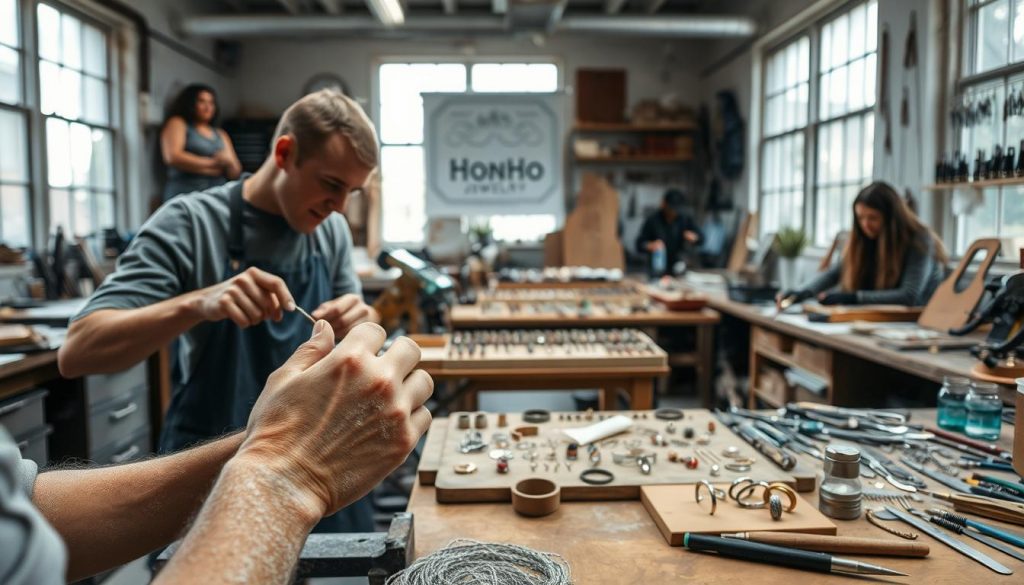
Traditional jewelry production is often linked to ecological degradation and human rights abuses. The conventional jewelry industry has a significant environmental footprint, affecting ecosystems worldwide. As consumers become more aware of these issues, the demand for sustainable jewelry makers and ethical jewelry artisans is on the rise.
Mining Practices and Ecological Damage
Mining practices in the jewelry industry often result in severe ecological damage. Deforestation, water pollution, and soil erosion are common consequences of mining operations. For instance, the extraction of gold often involves the use of toxic chemicals like mercury and cyanide, which can contaminate water sources and harm local wildlife.
The environmental impact of mining is not limited to the extraction process itself. Infrastructure development, such as roads and buildings, further contributes to habitat destruction. Moreover, the energy required for mining operations is typically generated by fossil fuels, adding to the overall carbon footprint.
Carbon Footprint of Jewelry Production
The carbon footprint of jewelry production encompasses various stages, from mining and refining to manufacturing and transportation. Each step in the supply chain contributes to greenhouse gas emissions, with the majority coming from energy-intensive processes like refining and smelting.
| Stage | Carbon Footprint Contribution |
|---|---|
| Mining | 30% |
| Refining and Smelting | 40% |
| Manufacturing | 20% |
| Transportation | 10% |
Human Rights Concerns in the Jewelry Industry
Human rights concerns are prevalent in some mining communities, where workers often face hazardous conditions and exploitation. Artisanal and small-scale mining operations, in particular, are known for poor labor practices and lack of regulatory oversight.
To address these issues, many ethical jewelry artisans are now prioritizing transparency and fair labor practices. By sourcing materials from certified suppliers and ensuring fair wages for workers, these companies are setting a new standard for the industry.
Materials Used in Eco-Friendly Jewelry
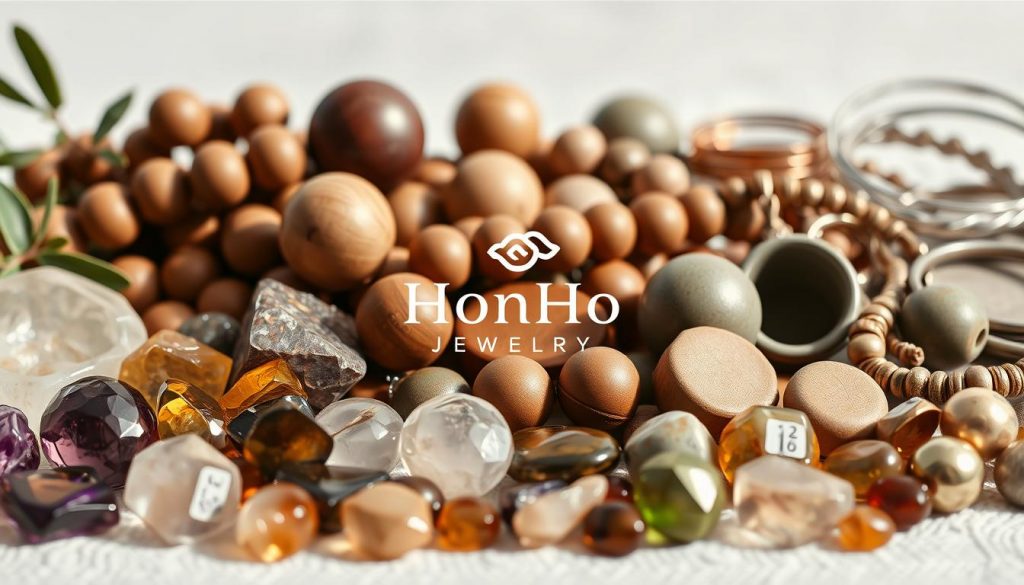
The jewelry industry is witnessing a significant transformation with the adoption of sustainable materials like recycled precious metals and lab-grown gemstones. As consumers become increasingly environmentally conscious, green jewelry brands are responding by incorporating eco-friendly materials into their designs.
Eco-friendly jewelry often incorporates a range of sustainable materials, reducing the demand for newly mined resources and minimizing environmental impact. Some of the key materials used include:
Recycled Precious Metals
One of the most significant advancements in sustainable fashion jewelry is the use of recycled precious metals. By reusing gold, silver, and platinum from old jewelry, electronics, and other sources, we can significantly reduce the need for primary mining. This approach not only conserves natural resources but also decreases the environmental footprint associated with mining activities.
Recycled precious metals are just as durable and valuable as their newly mined counterparts, making them an attractive option for consumers looking for sustainable jewelry. Many green jewelry brands now prioritize the use of recycled metals in their collections.
Lab-Grown Diamonds and Gemstones
Lab-grown diamonds and gemstones are another crucial component of eco-friendly jewelry. These stones are created using advanced technologies that replicate the natural processes of diamond and gemstone formation, but with a significantly lower environmental impact.
Lab-grown diamonds, for instance, have the same physical, chemical, and optical properties as mined diamonds but are produced with minimal environmental damage. This makes them an appealing choice for consumers seeking sustainable fashion jewelry that doesn’t compromise on quality or aesthetics.
Alternative Sustainable Materials
Beyond recycled metals and lab-grown gemstones, the industry is exploring a range of alternative sustainable materials. These include materials derived from recycled sources, such as recycled glass or repurposed wood, as well as innovative materials like bioplastic and plant-based composites.
The use of these alternative materials not only reduces waste but also offers unique design opportunities, allowing for the creation of truly distinctive and sustainable fashion jewelry pieces.
How to Identify Truly Sustainable Jewelry

With the rise of sustainable living, distinguishing between genuinely eco-friendly jewelry and mere marketing gimmicks is crucial. As consumers, we need to be equipped with the knowledge to make informed decisions that align with our values.
Understanding Sustainability Certifications
Sustainability certifications play a vital role in identifying ethical and sustainable jewelry. These certifications ensure that the jewelry is made with environmentally friendly practices and adheres to strict social standards.
- Fairtrade Gold Certification: Ensures that gold is mined under fair labor conditions and with environmentally responsible practices.
- Conflict-Free Diamond Certification: Verifies that diamonds are sourced from mines that do not contribute to armed conflicts.
- Recycled Precious Metals Certification: Confirms that the precious metals used are recycled, reducing the need for new mining.
When shopping for sustainable handmade jewelry, look for these certifications to ensure that your purchase supports ethical practices.
Researching Supply Chain Transparency
A transparent supply chain is a hallmark of truly sustainable jewelry brands. We must research the brand’s sourcing practices to ensure they align with our ethical standards.
“Transparency is key to ensuring that our jewelry is not only beautiful but also responsibly sourced.” –
To verify supply chain transparency, check if the brand:
- Publishes detailed reports on their sourcing practices.
- Provides information on their suppliers and partners.
- Engages in regular audits to ensure compliance with their sustainability policies.
Recognizing Greenwashing in Marketing
Greenwashing is a practice where companies misleadingly promote their products as eco-friendly. To avoid falling prey to greenwashing, we must critically evaluate the marketing claims made by jewelry brands.
| Red Flags | What to Look For |
|---|---|
| Vague or undefined terms like “eco-friendly” | Look for specific certifications or detailed explanations. |
| Overemphasis on a single sustainable aspect | Check if the brand addresses other aspects of sustainability comprehensively. |
| Lack of third-party verification | Ensure that sustainability claims are backed by credible third-party certifications. |
By being aware of these tactics, we can make more informed choices when purchasing ethical and sustainable jewelry.
Leading Sustainable Jewelry Companies in the Market

As consumers become more environmentally conscious, leading sustainable jewelry companies are stepping up to meet the demand for eco-friendly jewelry. These companies are not only adopting sustainable materials and production methods but are also innovating and pushing the boundaries of what is possible in eco-friendly jewelry.
Pioneers in Ethical Jewelry Production
Pioneers in ethical jewelry production are setting new standards in the industry. Companies like Brilliant Earth and Alex and Ani are leading the way by prioritizing ethical sourcing and production methods.
Brands with Comprehensive Sustainability Practices
Brands with comprehensive sustainability practices are making significant impacts. For instance, Tiffany & Co. has implemented a range of sustainability initiatives, from sourcing conflict-free diamonds to using recycled precious metals.
Companies with Innovative Eco-Friendly Approaches
Companies are also innovating with new eco-friendly approaches. Catbird is a notable example, using recycled metals and conflict-free gemstones in their designs.
| Company Name | Key Sustainability Features |
|---|---|
| Brilliant Earth | Ethical sourcing, recycled metals |
| Alex and Ani | Eco-friendly packaging, charitable giving |
| Tiffany & Co. | Conflict-free diamonds, sustainability reports |
| Catbird | Recycled metals, conflict-free gemstones |
How to Verify a Jewelry Company’s Sustainability Claims
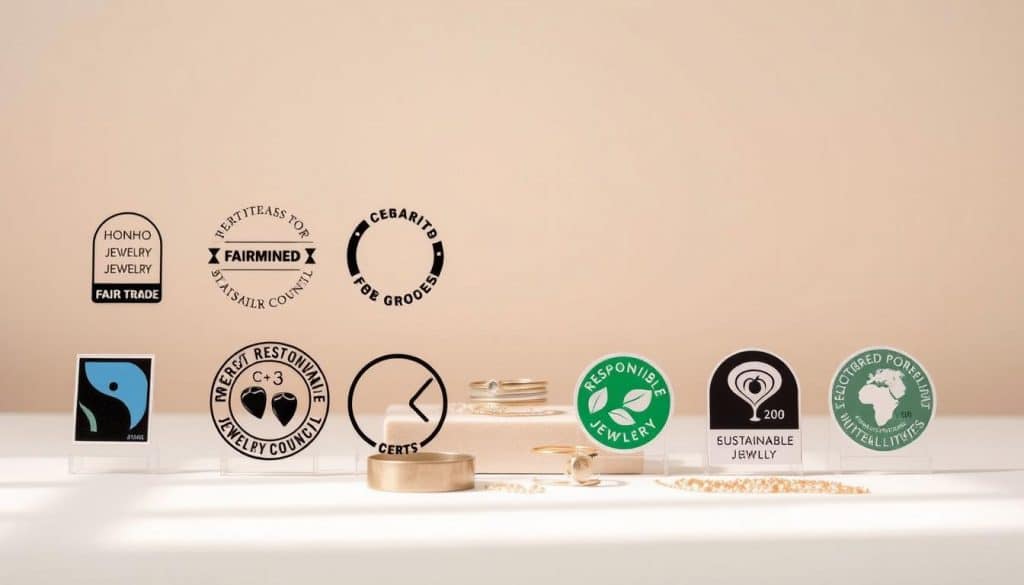
As consumers become more eco-conscious, verifying the sustainability claims of jewelry companies has become increasingly important. With numerous brands claiming to be environmentally friendly, it’s crucial to know how to distinguish between genuine sustainability efforts and mere marketing tactics.
Investigating Company Transparency Reports
A key step in verifying a jewelry company’s sustainability claims is to investigate their transparency reports. These reports should provide detailed information about their sourcing practices, supply chain management, and environmental impact. We look for companies that publish annual sustainability reports or regularly update their websites with relevant data.
For instance, companies like Brilliant Earth and Pandora are known for their transparent reporting. They provide insights into their sourcing practices, labor conditions, and environmental stewardship. When reviewing these reports, we pay attention to specific metrics such as carbon footprint, water usage, and waste management practices.
| Company | Transparency Report Highlights | Sustainability Metrics |
|---|---|---|
| Brilliant Earth | Detailed sourcing practices, conflict-free diamonds | Carbon neutral, recycled metals |
| Pandora | Supply chain transparency, responsible mining | 100% recycled silver, sustainable packaging |
Checking Third-Party Certifications
Another crucial step is to check for third-party certifications that validate a company’s sustainability claims. Certifications such as Fairtrade, Responsible Minerals Initiative, and Conflict-Free Sourcing are indicators of a company’s commitment to ethical practices. We look for companies that have undergone rigorous audits and have been certified by reputable organizations.
For example, Fairmined certification ensures that gold has been mined in a responsible manner, benefiting local communities and minimizing environmental impact. Companies that achieve such certifications demonstrate their dedication to sustainability.
Reading Customer Reviews and Industry Assessments
Customer reviews and industry assessments provide valuable insights into a company’s sustainability practices. We read reviews on multiple platforms to understand customer experiences and perceptions. Additionally, industry assessments from organizations like the Jewelry Council offer expert evaluations of a company’s sustainability efforts.
By combining these sources of information, we can form a comprehensive view of a jewelry company’s commitment to sustainability. This holistic approach helps us make informed decisions when choosing eco-friendly jewelry options.
Sustainable Fine Jewelry Options
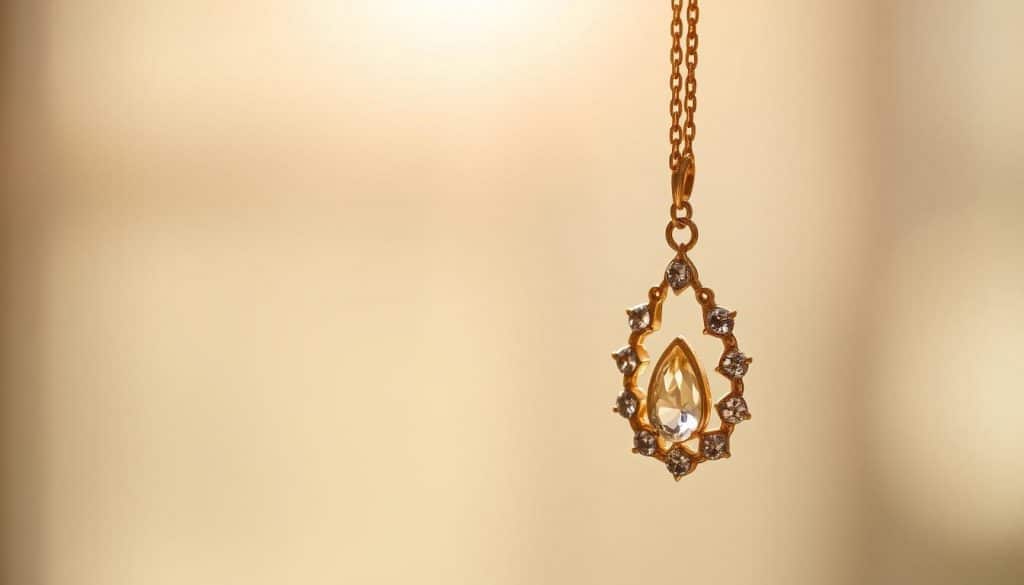
As consumers become more environmentally aware, the demand for sustainable fine jewelry has seen a notable increase. This shift is driven by a growing desire to align luxury purchases with personal values, particularly among younger generations. We are witnessing a significant transformation in the fine jewelry industry, with sustainable jewelry makers and ethical jewelry artisans leading the way.
Eco-Friendly Engagement Rings and Wedding Bands
Engagement rings and wedding bands are significant investments, both financially and emotionally. Traditionally, these pieces have been associated with environmental and ethical concerns due to mining practices. However, there’s now a wide range of eco-friendly options available:
- Recycled precious metals reduce the need for new mining.
- Lab-grown diamonds offer a sustainable alternative to mined diamonds.
- Conflict-free gemstones ensure that the beauty of the jewelry doesn’t come at a human cost.
According to a recent survey, “71% of millennials prefer to buy sustainable products, even if they cost a bit more.” This statistic underscores the growing importance of sustainability in consumer purchasing decisions, including for fine jewelry.
Sustainable Diamond and Gemstone Alternatives
The traditional diamond and gemstone mining industry has faced criticism for its environmental impact and labor practices. In response, the industry has innovated, offering alternatives such as:
- Lab-grown diamonds, which have the same physical properties as mined diamonds but with a significantly lower environmental footprint.
- Recycled gemstones, which reduce waste and the demand for new mining.
- Alternative gemstones like moissanite or recycled sapphires, which offer unique beauty and sustainability.
“The future of fine jewelry is not just about luxury, but about making a positive impact on the planet.” –
Investment-Quality Sustainable Jewelry Pieces
Sustainable fine jewelry is not just for everyday wear; there are also investment-quality pieces that combine luxury with eco-friendliness. These include:
- High-end, eco-friendly diamond jewelry made with recycled metals and conflict-free stones.
- Artisanal pieces crafted by skilled, ethical jewelry artisans who prioritize sustainability.
- Unique, limited-edition collections that highlight the craftsmanship and commitment to sustainability of the maker.
Investing in sustainable fine jewelry is a statement of values, a choice that reflects a commitment to the environment and ethical practices. As we move forward, the intersection of luxury and sustainability will continue to evolve, offering consumers more options that align with their values.
Eco-Friendly Fashion Jewelry Brands
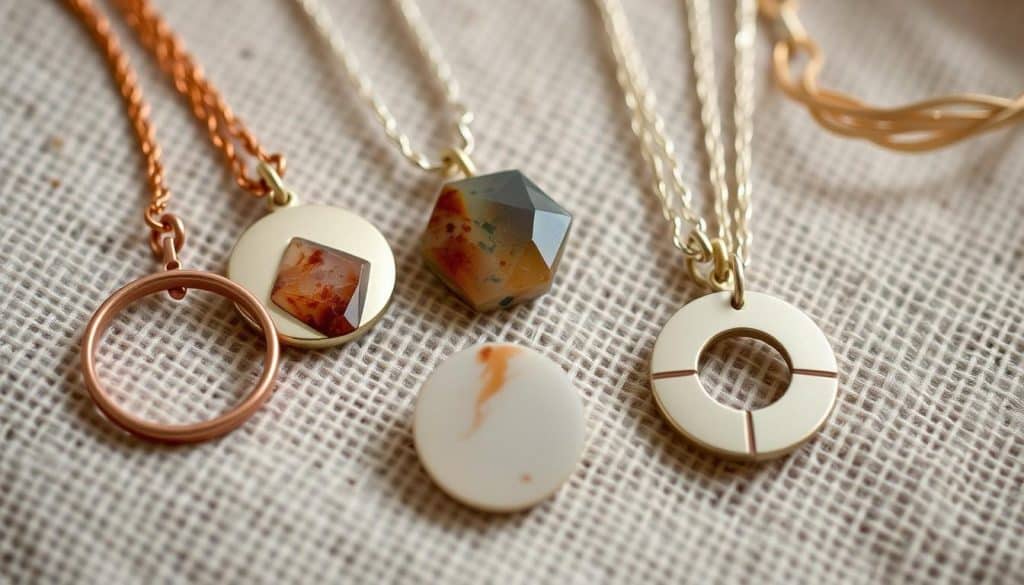
As consumers become more environmentally aware, eco-friendly fashion jewelry brands are gaining popularity. The shift towards sustainability in the fashion jewelry industry is not just a trend, but a necessary change driven by consumer demand for more responsible practices.
We are witnessing a significant transformation in how fashion jewelry is designed, produced, and marketed. Eco-friendly fashion jewelry brands are now offering stylish, affordable, and sustainable options that cater to the environmentally conscious consumer.
Affordable Daily Wear Sustainable Options
Many eco-friendly fashion jewelry brands are making daily wear more sustainable without compromising on style or budget. These brands use recycled materials, sustainable packaging, and environmentally friendly production methods to minimize their ecological footprint.
For instance, some brands are utilizing recycled metals and conflict-free gemstones, ensuring that their products are not only beautiful but also sustainable. Recycled precious metals and lab-grown gemstones are becoming increasingly popular in fashion jewelry, offering a guilt-free alternative for daily wear.
Trendy Statement Pieces with Environmental Consciousness
Fashion jewelry is not just about accessorizing; it’s also about making a statement. Eco-friendly fashion jewelry brands are now creating trendy statement pieces that are both stylish and sustainable. These pieces are designed to make a fashion statement while promoting environmental consciousness.
From bold, eco-friendly earrings made from recycled materials to sustainable necklaces featuring lab-grown gemstones, these statement pieces are redefining fashion jewelry. Brands are incorporating innovative materials and production techniques to create unique, eye-catching pieces that are also environmentally friendly.
Seasonal Collections with Sustainable Materials
Many eco-friendly fashion jewelry brands are now releasing seasonal collections that feature sustainable materials and production methods. These collections not only keep up with the latest fashion trends but also adhere to the principles of sustainability.
By using sustainable materials and minimizing waste, these brands are setting a new standard in the fashion jewelry industry. Their seasonal collections offer consumers the opportunity to stay fashionable while supporting environmentally responsible practices.
In conclusion, the rise of eco-friendly fashion jewelry brands is a positive step towards a more sustainable future in the fashion industry. As consumers, we have the power to drive change by choosing brands that prioritize the environment. By supporting green jewelry brands and sustainable fashion jewelry, we are not only enhancing our personal style but also contributing to a more sustainable world.
Handcrafted Sustainable Jewelry Artisans
As consumers increasingly seek eco-friendly options, handcrafted sustainable jewelry artisans are stepping into the spotlight. These skilled makers are not only creating beautiful pieces but also contributing to a more ethical and environmentally conscious jewelry industry.
Finding and Supporting Independent Eco-Conscious Makers
Discovering local, independent artisans who prioritize sustainability can be a rewarding experience. We recommend exploring local craft fairs, online marketplaces, and social media platforms to find these talented individuals. By supporting independent eco-conscious makers, consumers can ensure that their purchases directly benefit the artisans and promote sustainable practices.
Some ways to find these artisans include:
- Attending local artisan markets and craft fairs
- Searching online platforms like Etsy for eco-friendly jewelry
- Following sustainable living and eco-friendly lifestyle influencers on social media
Custom Sustainable Jewelry Options
One of the significant advantages of working with handcrafted sustainable jewelry artisans is the ability to commission custom pieces. Whether you’re looking for a unique engagement ring or a personalized gift, these artisans can work with you to create a piece that not only reflects your personal style but also aligns with your values.
Custom sustainable jewelry options may include:
- Using recycled or repurposed materials
- Incorporating conflict-free gemstones or lab-grown diamonds
- Designing pieces that tell a personal story or hold sentimental value
Local Artisans with Ethical Practices
Local artisans who adhere to ethical practices are crucial to the sustainable jewelry movement. We appreciate artisans who prioritize environmentally friendly materials, fair labor practices, and transparent supply chains. By choosing to support local artisans, consumers can foster a more sustainable local economy and reduce the carbon footprint associated with long-distance shipping.
Here is a comparison of traditional jewelry manufacturing versus sustainable handcrafted jewelry:
| Aspect | Traditional Jewelry | Sustainable Handcrafted Jewelry |
|---|---|---|
| Materials | Often uses newly mined precious metals and gemstones | Frequently incorporates recycled materials and conflict-free gemstones |
| Labor Practices | May involve questionable labor practices | Typically adheres to fair labor standards |
| Environmental Impact | Can have significant ecological damage due to mining | Generally has a lower environmental impact due to sustainable sourcing |
By choosing handcrafted sustainable jewelry, consumers can enjoy unique, meaningful pieces while supporting ethical practices and reducing environmental impact. As the demand for eco-friendly jewelry continues to grow, the role of independent artisans will become increasingly vital in shaping a more sustainable future for the industry.
How to Care for Your Eco-Friendly Jewelry
Maintaining your eco-friendly jewelry not only preserves its beauty but also its environmental credentials. Proper care ensures that your pieces remain in excellent condition, reducing the need for frequent replacements and supporting the overall sustainability of your jewelry collection.
Non-Toxic Cleaning Methods
Cleaning your sustainable handmade jewelry requires gentle, non-toxic methods to preserve its integrity. We recommend using a soft-bristled toothbrush and mild soap with warm water to clean intricate designs. For tougher stains, a mixture of equal parts water and white vinegar can be effective.
- Avoid harsh chemicals and abrasive materials that can damage the jewelry.
- Use a soft cloth to dry your jewelry thoroughly after cleaning.
- For sterling silver pieces, consider using a gentle silver polish that is free from harsh chemicals.
Sustainable Storage Solutions
Proper storage is crucial for maintaining the quality of your ethical and sustainable jewelry. Store each piece separately in a cool, dry place to prevent tarnishing and scratching. Consider using recycled or sustainably sourced storage materials, such as wooden or recycled paper jewelry boxes.
| Storage Material | Sustainability Benefits |
|---|---|
| Recycled Paper | Reduces waste and conserves natural resources. |
| Sustainably Sourced Wood | Promotes responsible forestry practices. |
| Natural Fabric | Biodegradable and gentle on jewelry. |
Repair and Maintenance for Longevity
Regular maintenance is key to extending the life of your eco-friendly jewelry. We advise checking your pieces regularly for signs of wear and tear, such as loose stones or worn prongs. For repairs, seek out jewelers who use sustainable practices and materials.
- Schedule regular inspections with a professional jeweler.
- Use eco-friendly cleaning methods to maintain the jewelry between inspections.
- Consider repurposing or upcycling old or damaged jewelry into new pieces.
By following these care guidelines, you can enjoy your ethical and sustainable jewelry for years to come, while also supporting environmentally responsible practices in the jewelry industry.
Creating a Sustainable Jewelry Collection
Building a sustainable jewelry collection requires a thoughtful approach to curating pieces that are both timeless and versatile. As consumers become more environmentally conscious, sustainable jewelry companies are gaining prominence for their commitment to eco-friendly practices.
Curating Timeless, Versatile Pieces
When building a sustainable jewelry collection, it’s essential to focus on pieces that won’t go out of style quickly. Timeless designs can be worn across various occasions and seasons, reducing the need for frequent purchases. We recommend investing in classic shapes and understated elegance that can be easily mixed and matched.
- Opt for simple, elegant designs that won’t go out of style.
- Consider the versatility of each piece and how it can be paired with other items in your collection.
- Invest in high-quality materials that are durable and long-lasting.
Combining Vintage and New Sustainable Items
Combining vintage and new sustainable jewelry can add depth and character to your collection. Vintage pieces often have a unique history and craftsmanship that can complement newer, eco-friendly items. Eco-friendly jewelry brands are now offering a range of sustainable options that can be paired with vintage finds.
| Benefits | Vintage Jewelry | New Sustainable Jewelry |
|---|---|---|
| Uniqueness | Often one-of-a-kind with historical significance | Unique designs with modern twists |
| Environmental Impact | Reduces waste by reusing existing materials | Made with eco-friendly materials and practices |
| Craftsmanship | Often features traditional craftsmanship | Combines modern techniques with sustainable materials |
Building a Collection That Reflects Your Values
Your jewelry collection should reflect your personal style and values. By choosing pieces from sustainable jewelry companies, you’re not only enhancing your collection but also supporting environmentally responsible practices. Consider the story behind each piece and how it aligns with your values.
By curating a collection that is both stylish and sustainable, you’re making a positive impact on the environment. We encourage you to explore the world of eco-friendly jewelry and discover the beauty of sustainable fashion.
The Future of Sustainable Jewelry Companies
As we look ahead, the future of sustainable jewelry companies is being shaped by innovative technologies and evolving consumer preferences. The industry is witnessing a significant transformation, driven by the need for more ethical and eco-friendly practices.
Technological Advancements
Emerging technologies are playing a crucial role in ethical jewelry production. Some of the key advancements include:
- Recycling technologies that allow for the reuse of precious metals and gemstones.
- Lab-grown diamonds and gemstones that reduce environmental impact.
- Blockchain technology for enhanced supply chain transparency.
- 3D printing for intricate designs with minimal waste.
These technologies are not only reducing the environmental footprint of jewelry production but also enabling environmentally conscious jewelry designers to create unique and sustainable pieces.
Industry Trends
The sustainable jewelry industry is expected to witness several key trends in the coming years. Some of the predicted trends include:
- Increased demand for transparency in sourcing and production.
- Growing popularity of recycled and upcycled materials.
- Rise of circular business models that promote jewelry reuse and recycling.
- More emphasis on carbon offsetting and neutralizing.
These trends are driven by consumer awareness and the desire for more ethical jewelry companies that prioritize sustainability.
Consumer-Driven Changes
Consumers are increasingly driving the demand for sustainable jewelry, pushing companies to adopt more eco-friendly practices. Key consumer-driven changes include:
- A preference for brands that prioritize sustainability and transparency.
- Increased scrutiny of supply chains and sourcing practices.
- Demand for products that are both beautiful and sustainable.
As consumers continue to drive change, ethical jewelry companies are responding by innovating and adapting to meet these new expectations.
Step-by-Step Guide to Shopping for Sustainable Jewelry
The journey to finding the perfect piece of sustainable jewelry involves several key considerations. As sustainable jewelry makers and ethical jewelry artisans continue to innovate, consumers have more options than ever. However, navigating these choices requires a thoughtful approach.
Questions to Ask Before Purchasing
Before making a purchase, it’s essential to ask the right questions. We recommend inquiring about the origin of the materials, the production process, and the brand’s sustainability policies. This information helps ensure that your jewelry is not only beautiful but also aligns with your values.
- What is the source of the materials used?
- How are the materials processed and crafted into jewelry?
- What sustainability certifications does the brand hold?
- How does the brand address environmental and social issues?
Navigating Online vs. In-Store Shopping
Both online and in-store shopping have their advantages when it comes to sustainable jewelry. Online platforms often provide detailed information about the products and the brand’s practices, while physical stores allow you to see the jewelry up close and assess its quality.
When shopping online, look for brands that offer transparent supply chains and detailed product descriptions. In-store, you can ask sales associates about the jewelry’s origins and the brand’s sustainability initiatives.
Making Informed Decisions Based on Your Values
Making an informed decision involves considering your personal values and how they align with the brand’s practices. We suggest evaluating the brand’s commitment to sustainability, ethical sourcing, and community engagement.
By choosing to support ethical jewelry artisans and sustainable jewelry makers, you’re not only acquiring a beautiful piece of jewelry but also contributing to a more sustainable and equitable industry.
Conclusion
As we have explored throughout this article, the shift towards sustainable jewelry is a positive trend that benefits both consumers and the environment. Sustainable jewelry companies are leading the way by adopting eco-friendly practices and promoting ethical sourcing.
We have seen how eco-friendly jewelry brands are making a difference by using recycled precious metals, lab-grown diamonds, and alternative sustainable materials. Ethical jewelry companies are also prioritizing transparency in their supply chains, ensuring that their products not only sparkle but also contribute to a more sustainable future.
By choosing sustainable jewelry, we are driving change through our purchasing decisions. We are supporting a industry that values quality, innovation, and expert craftsmanship, while also minimizing its environmental footprint.
As consumers, we have the power to shape the future of the jewelry industry. By opting for sustainable jewelry companies, we are promoting a culture of sustainability and responsibility. Let’s continue to make informed choices that benefit both our wardrobes and the planet.
FAQ
What makes a piece of jewelry sustainable?
A piece of jewelry is considered sustainable if it is made with eco-friendly materials, such as recycled precious metals and lab-grown diamonds, and produced using environmentally conscious methods. Sustainable jewelry companies prioritize reducing their environmental footprint and promoting ethical sourcing.
How can I identify truly sustainable jewelry?
To identify truly sustainable jewelry, look for sustainability certifications, research a brand’s supply chain transparency, and be aware of greenwashing practices. Check for third-party certifications and read customer reviews and industry assessments to verify a company’s sustainability claims.
What are some eco-friendly materials used in sustainable jewelry?
Eco-friendly materials used in sustainable jewelry include recycled precious metals, lab-grown diamonds, and alternative sustainable materials. These materials reduce the environmental impact of jewelry production and offer consumers stylish and ethical choices.
How can I care for my eco-friendly jewelry?
To care for your eco-friendly jewelry, use non-toxic cleaning methods, store your jewelry in sustainable storage solutions, and practice repair and maintenance to extend the life of your pieces.
What are some leading sustainable jewelry companies?
Some leading sustainable jewelry companies include those that prioritize eco-friendly materials, production methods, and supply chain transparency. These companies are innovating and pushing the boundaries of sustainable jewelry, offering a range of eco-friendly and ethical options.
How can I verify a jewelry company’s sustainability claims?
To verify a jewelry company’s sustainability claims, investigate their transparency reports, check for third-party certifications, and read customer reviews and industry assessments. This will help you make informed purchasing decisions that align with your values.
What are some sustainable fine jewelry options?
Sustainable fine jewelry options include eco-friendly engagement rings, sustainable diamond and gemstone alternatives, and investment-quality sustainable jewelry pieces. These options not only look beautiful but also align with ethical and environmental values.
How can I build a sustainable jewelry collection?
To build a sustainable jewelry collection, curate timeless, versatile pieces, combine vintage and new sustainable items, and prioritize eco-friendly and ethical jewelry options. This will help you create a collection that is both stylish and meaningful.
What is the role of independent artisans in the sustainable jewelry movement?
Independent artisans play a crucial role in the sustainable jewelry movement by creating handmade, eco-friendly jewelry pieces that prioritize ethical practices. Supporting these artisans helps promote sustainability in the jewelry industry.
What are some predicted industry trends for sustainability in jewelry?
Predicted industry trends for sustainability in jewelry include the adoption of emerging technologies, increased transparency, and consumer-driven changes. As consumers, we have the power to drive change through our purchasing decisions, opting for eco-friendly and ethical jewelry options.
share this recipe:
Still hungry? Here’s more

Gold Filled vs Vermeil Guide Differences Durability and Value
What Is Gold Filled Jewelry? Gold filled jewelry is my go-to recommendation when someone wants

How Much for a Gold Necklace 2026 Price Guide and Tips
Understanding Gold Purity and Karats When people ask “how much for a gold necklace?”, the

Spiritual Jewelry Symbols Guide- Meanings and How to Choose
How to Use This Spiritual Jewelry Symbols Guide Spiritual jewelry only works for you when
Ready to Design Your Own Jewelry?
Have an idea in mind or need help shaping it? From sketches to finished pieces, our custom jewelry team will work with you step-by-step to bring your vision to life.
